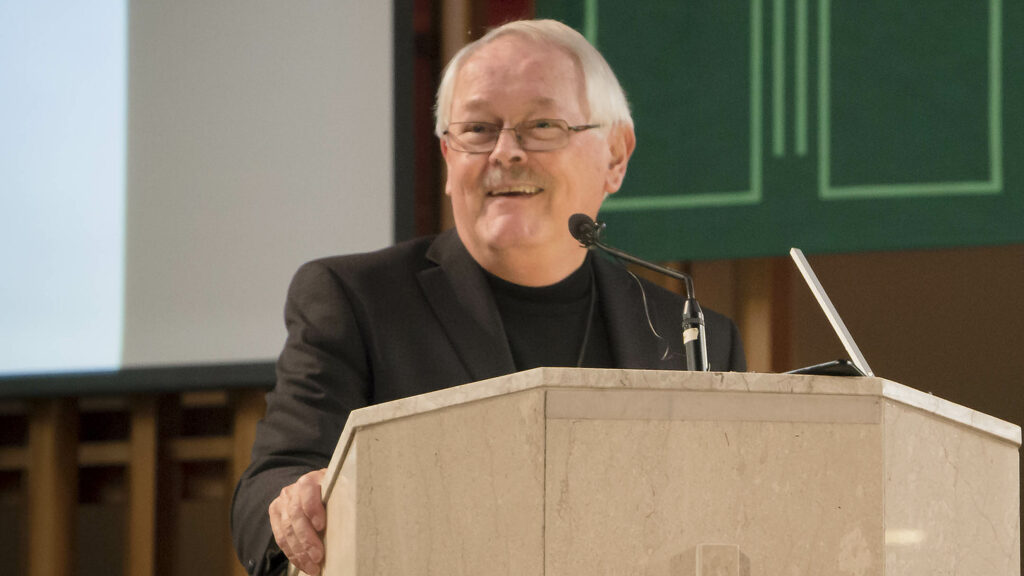Rev. Ron Rolheiser
Sometimes it takes an outsider to help you to see the beauty and depth of something you have never fully appreciated. I suspect this true for many of us, myself no exception, regarding the celebration of the Eucharist in our churches.
David P. Gushee, an Evangelical, recently published a book entitled After Evangelicalism, within which he describes his decades-long struggle to make peace with some issues inside his own church. He has remained in his church, though now on Sundays he also goes (with his wife who is a Roman Catholic) to a Catholic Mass. Here’s his description of what he sees there.
“I view design of the Catholic Mass as something like a polished gem, refined over time to a state of great beauty – if you know what you are looking at. … The movement of the Mass manages to accomplish so much in something like an hour – a processional, with the cross held high; greetings in the name of the triune God; early confession of sin, brief but compelling; an Old Testament reading read by a lay person; a sung psalm; an Epistle reading by a layperson; the Gospel reading by the priest, and the ceremony around it; a brief homily; the centering movement provided by the creed and the prayers of the people. An offertory and music. Then right to the Table – the people offer gifts that are then offered to God and come back to the people as Christ’s body and blood; the kneeling in humility; the Lord’s Prayer as an important part of the Eucharistic rite; the precious chance to pass the peace with neighbors just before the supper; more kneeling; the chance to watch the people come up for Communion and pray for them, or instead be quiet with God; the final Trinitarian blessing and recessional.”
What an insightful description of the ritual by which we celebrate the Eucharist! Sometimes when we’re inside something, we don’t see it as clearly as does someone from the outside.
Let me add two other descriptions that highlight the Eucharistic ritual in a way that we often don’t think about or meet in our usual theology and catechesis on this.
The first, like Gushee’s, also comes from a non-Catholic. A Methodist layman shares this: “I’m not a Roman Catholic, but sometimes I go to a Roman Catholic Mass just to take in the ritual. I’m not sure if they know exactly what they’re doing, but they’re doing something very powerful. Take their daily Mass, for example. Unlike their Sunday Mass, they do daily Mass more simply, with the ritual stripped down to its skeleton. What you see then, in essence, is something akin to an Alcoholics Anonymous meeting.” Why does he make that connection?
Here are his words. “People who go to daily Mass don’t go there to experience anything novel or exciting. It’s always the same, and that’s the point. Like people going to an Alcoholics Anonymous meeting, they’re going there to receive the support they need to stay steady in their lives, and the steadiness comes through the ritual. Underneath the surface, each person is saying, “My name is ___ and my life is fragile. I know that if I don’t come to this ritual regularly my life will begin to unravel. I need this ritual to stay alive.” The ritual of the Eucharist functions too as a “12-Step” meeting.
Another perspective comes from Ronald Knox, a British theologian. He submits that we have never truly been faithful to Jesus. When we’re honest, we have to admit that we don’t love our enemies, don’t turn the other cheek, don’t bless those who curse us, don’t forgive those who kill our loved ones, don’t reach out enough to the poor, and don’t extend our compassion out equally to the bad as well as to the good. Rather, we cherry-pick the teachings of Jesus. But, says Knox, we have been faithful in one great way, through the ritual of the Eucharist. Jesus asked us to keep celebrating that ritual until he returns and, 2000 years later, we are still celebrating it. The ritual of the Eucharist is our one great act of fidelity, and the good news is that this ritual will ultimately be enough.
Jesus left us two things: his Word and the Eucharist. Various churches have taken different approaches as to which of these to give priory. Some churches, like Roman Catholics, Episcopalians, and Anglicans have prioritized the Eucharist as the foundation on which they build and maintain community. Other churches, most Protestant and Evangelical communities, have reversed this and prioritized the Word as the foundation on which they build and maintain community. How do the Word and the Eucharist play out together?
On the Road to Emmaus when the disciples of Jesus fail to recognize him even as they are walking with him, Jesus stirs their hearts with the Word, enough so that they beg him to stay with them. Then he sits down with them for Eucharist, and the ritual does the rest.

